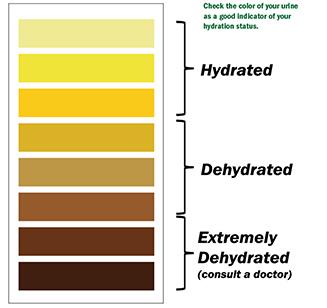Main Menu
0 - Access key details
1 - scroll top
2 - header search
1 - scroll top
2 - header search
Hydrate
Daily Hydration Needs:
- Water should be your main source of hydration.
- Avoid drinking soda, energy drinks and fruit drinks. These beverages provide a lot of calories with
very little nutritional value. - Limit sweetened teas and coffee drinks with added sugar and cream.
- Only choose sports drinks before, during and after intense exercise.
Hydration Considerations In Extreme Environments
In extreme environments it is even more important to be aware of your fluid intake, fluid loss and electrolyte needs.
- Key Nutrition Tips for Extreme Environments:
- Do not skip meals.
- Take time to drink.
- Maximize taste/palatability (temperature, sweetness) of your beverage. If it tastes great, you are more likely to drink it.
- Minimize body water losses.
- Consider engineered food products when cramping risks are high, if you are a salty sweater, or if you are sweating more than usual.
- Choose sports drinks with at least 110mg sodium and 30mg potassium per 8oz/250ml. These are ideal for replacing electrolytes lost in sweat.
- If you are an excessively salty sweater (salty skin), then 200mg sodium per 8oz or added electrolytes should be considered. (Nuun Tablets,
Gator-Lytes, etc…) - Include whole foods in your meals that are higher in sodium. Good options are V8 Juice, pickles, pretzels, adding a little extra salt to your meals.
| ENVIRONMENT | CONSIDERATION | HYDRATION RECOMMENDATIONS |
|---|---|---|
| Dry Extreme Heat | The extreme dry heat greatly increase the risk for dehydration and heat injury. | Suggested Fluid Intake: 5-12 Liters/day Tips: Sweating rates can be reduced by working at night. During daylight hours, sweating rates can be reduced by covering the skin with light, vapor-permeable clothing. If and when possible, drink COLD water and sports drink. |
| Hot and Humid | Relative humidity can increase water requirements independent of temperature. The humidity makes the evaporation of sweat off the skin difficult, which decreases the body’s ability to cool itself. This increases the risk for dehydration and heat exhaustion. Excessive sweating can also cause a large loss of electrolytes, specifically sodium and potassium. | Suggested Fluid Intake: Up to 2x needs of Extreme Dry Heat Tips: If and when possible drink COLD water and sports drink. |
| Altitude | Altitude puts us at greater risk of dehydration. More fluid is lost through our urine and breathing. Layers of clothes may cause us to sweat more with little evaporation. The elevation also causes us to not feel as thirsty. |
Suggested Fluid Intake: 4-6 Liters/day Tips: Drinking small quantities of fluid frequently results in less urine production than drinking large quantities of fluid less frequently. |
| Altitude and Cold | The addition of cold to altitude can cause greater risk for dehydration because of the sweat losses that occur in insulated clothing, low rates of fluid ingestion, and concern of having to remove clothing to urinate. | Suggested Fluid Intake: 5.5-7.5 Liters/day Tips: Make sure to consider the ventilation for your clothing to allow for sweating to dissipate heat. Drinking small quantities of fluid frequently results in less urine production than drinking large quantities of fluid less frequently. If and when possible consume hot fluids, tea, chicken/vegetable broth. |
Are you hydrated?
- If you are thirsty, it is too late.
- Evaluate your urine. It should be light in color and resemble pale lemonade.
To maintain hydration, drink water.
| Body Weight | Ounces of Fluid Needed per Day | Liters per Day |
|---|---|---|
| 120 pounds | 60–120 ounces | 2–4 liters/day |
| 150 pounds | 75–150 ounces | 2.5–5 liters/day |
| 175 pounds | 90–175 ounces | 3–6 liters/day |
| 200 pounds | 100–200 ounces | 3.5–7 liters/day |
| 225 pounds | 115–225 ounces | 4–8 liters/day |
| 250 pounds | 125–250 ounces | 4.5–9 liters/day |
Note: .5-1 ounces of fluid per pound per day [there are about 33 ounces in a liter].
Hydration Urine Chart
Check the color of your urine as a good indicator of your hydration status.

